Quick, Custom and Unusual Parts via Additive Manufacturing
Latest News
December 1, 2011
Applications of rapid prototyping and manufacturing, regardless of the technology used, have spread well beyond the industrial, aerospace and medical arenas of the past decade. DE takes a look at some far-reaching, innovative uses that might surprise and inspire you.
Magic Flutes, Magic Photos
Amit Zoran, a student at the Massachusetts Institute of Technology, used an Objet Connex 500 3D additive manufacturing (AM) system to print a flute. Yes, a concert flute, with full mechanical keywork—created in just four parts, then assembled with the addition of metal springs. Zoran, working at the MIT Media Lab, took advantage of the Objet system’s ability to jet or “print” with more than one plastic-like material on the fly: a rigid material for the flute’s body, a black rubbery material for the pads and a soft, clear material for the mouthpiece. Run-time was about 15 hours. Check out the video:
Built to make the point that this process can create an instrument that is both ergonomically and acoustically comparable to a standard metal-based flute, the design could use some “fine-tuning.” However, it sounds amazingly good, and demonstrates the possibilities of fabricating intricate, non-techy products in short timeframes, using classic or entirely new designs.
Looking for a different way to reach out and touch someone? Digital Forming is a UK-based company (and a sister company to Within Technologies), developing a service for businesses that brings together online design and various AM services. What’s unique about its technology—soon to be accessible on UCODO.com (User Co-Designed Objects)—is how the interface readily engages non-CAD users in “shape changing” a product’s image file to customize its 3D design. One video shows this being done on a lemon-squeezer.
“We wanted to make it quite intuitive,” says Lisa Harouni, Digital Forming’s CEO. “The interesting thing is that it’s a collaborative design platform. Its tools can be used not just by brands to engage customers in the next level of customization, but also by engineers and product designers. You want to allow that team to co-concept products—for example, to have the input of a management team that doesn’t know how to design or of a user/test group.” The aim, eventually, is to enable local AM manufacturing. Current efforts use EOS laser-sintering systems.
One fun test project at Digital Forming is a new take on greeting cards. Proprietary image-processing software converts each shade of a digital-camera photo into a different physical thickness. An EOS laser-sintering system uses this information to build an all-white plastic bas-relief “card.” When viewed against a light source, the card displays the full shading of a black-and-white image.
A digital color photo has been converted (with proprietary software) into a thin, EOS-laser-sintered plastic bas-relief comprised of varying thicknesses. When the card is held up to the light, the thicknesses transmit light of varying amounts, giving the appearance of a black-and-white photo. Images courtesy Digital Forming.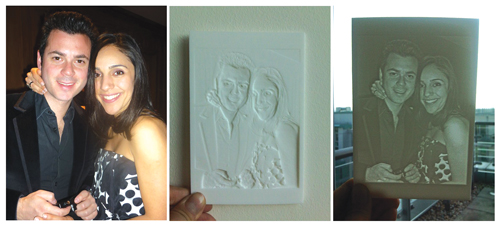
A customer of Mcor Technology—developers of the office-friendly layered-paper printer—has taken 3D imagery in a very different direction. Innermost Secrets in Cardiff, Wales, a private specialist in women’s health, regularly provides pregnancy ultrasound scans and was seeking a new way to capture full 3D data. Dr. Bryan Beattie, the practice director, commissioned a software development project to turn the non-proprietary files from the ultrasound scanner into commercial 3D files, which could then be output to various types of 3D cutting and printing equipment.
“We were looking for a cost effective, eco-friendly method of producing a 3D print of our baby scans,” explains Beattie. “The Mcor Matrix 3D printer provided us with the perfect solution. It provides value for the money, and its eco-friendly credentials are very important to our customers.” When built from bonded sheets of white paper, the 3D images have the look of carved cameos.
Imagery and Abstractions
Technology from Z Corp. was a crucial link in the process of identifying the remains of a WWI soldier found years ago at a construction site near Avion, France. Andrew Nelson, a key researcher on the project and associate dean of research for social science at the University of Western Ontario, explained that although there were several large skull fragments, for this case, DNA testing was not a viable option.
CT scans provided enough data to create a physical model using a Z Corp. 3D printer. The research team then worked with artist Christian Corbet to construct a rudimentary face over the model. By superimposing photos of the model onto photos of potential matches and assessing the agreement, they found their man: Private Thomas Lawless, born in Dublin in 1889 and killed in action as a member of the 49th Battalion, Canadian Expeditionary Force. Nelson observes, “This may result in a new protocol for identification of the missing.”
A Z Corp. 3D-printed skull model played a role in assisting with the identification of the skeletal remains of a WWI soldier. CT scans of the few fragments provided the data for constructing the ZCorp. model. Image courtesy Z Corp.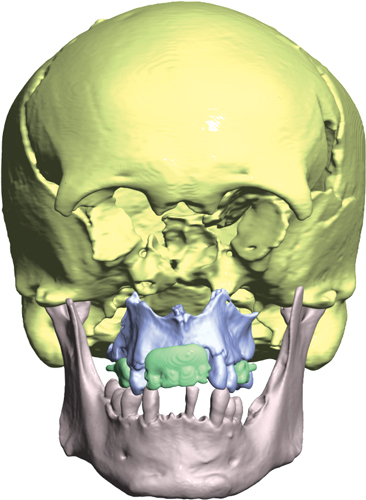
From the specific to the abstract, pushing the limits of physical art is on the agenda for Jason Pilarski’s students at the Art Center College of Design in Pasadena, CA. Art Center graduates include designers for several automobile manufacturers, as well as film and broadcast professionals, graphic designers, product design specialists and artists.
One of the college’s major student resources is its 3D Lab, founded by Pilarski 10 years ago, which includes additive and subtractive processing equipment. In the latter group are two Roland MDX desktop milling systems.
Artwork done by university student Jacqueline Huang under the direction of Professor Jason Pilarski at the Art Center College of Design, using a Roland MDX desktop milling system. The hexagonal pattern was milled from urethane plastic, and the rounded shapes are from high-density urethane foam. Image courtesy Roland.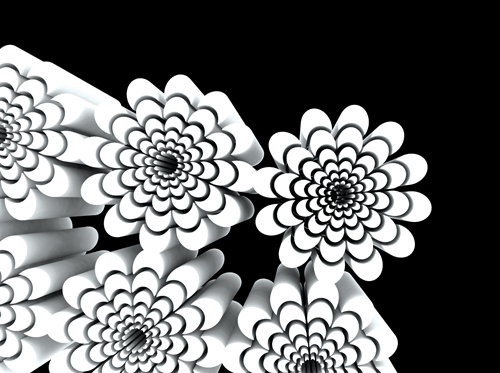
“We needed a prototyping machine that the students could operate themselves,” says Pilarski. “Being able to create their designs in 3D is a tremendous teaching tool.”
Pilarski estimates that between his classes and those taught by other instructors, students use the Roland systems to create more than 200 different projects each year. Materials used include tiles, foams, plastics and RenShape modeling boards; sample projects include interlocking repeated parts (think Escher prints) and bas-relief/full 3D art.
Although crafting small AM parts with fine detail is a critical achievement, thinking big is also an admirable goal—leading to new, mind-bending applications. Picture a freeform sculpture standing 10 ft. tall, or even a building “grown” on-site simply from sand and a binder.
Enrico Dini, founder and chairman of Pisa, Italy-based Dinitech, has combined inspiration by architect Antoni Gaudi with experience in civil engineering to devise a large-scale AM construction method. Termed D_Shape, the CAD-driven process solidifies ordinary sand with an inorganic binding “ink;” the results are structures unlimited by standard constraints of geometry and material.
The D_Shape system is assembled as a rigging over the build site. Two hoses provide the build materials. No water is needed, and because the components mix outside the nozzles, the machine does not clog. Also, because no limestone is heated in the process, no carbon dioxide (as with cement formation) is created. D_Shape equipment can print layers of 5 to 10mm at 25 dpi, with final parts as large as 6x6x1m.
Dini has already built the model for a freeform gazebo sculpture designed by Andrea Morgante of Shiro Studio, London. The full-size form will be installed as public art in the center of a Pisa roundabout. For marketing efforts outside Italy, Monolite UK is the first licensee.
Can life-size sandcastles be next?
Really Outside the Box
Did you catch the September unveiling of the ber-efficient Urbee (urban-electric) car at TEDxWinnepeg? This sleek, two-person prototype from Canadian company Kor Ecologic is the embodiment of a team that sees “the way things should be” for vehicle design and production (See “3D Printing Accelerates Cars into the Future,” DE March 2011).
While this is a rendition of the Kor Ecologic two-seater Urbee car, the first operating model has recently been built. Stratasys Fortus AM machines produced all the body panels. Image courtesy Stratasys and Kor Ecologic.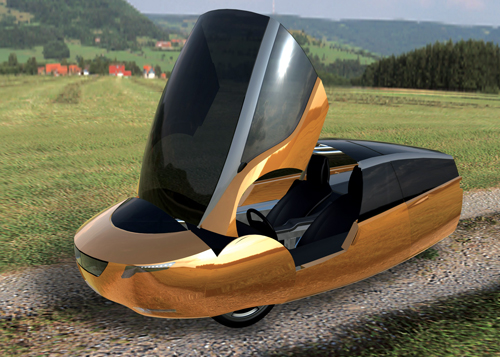
Kor Ecologic’s vision for this project includes using materials available as close as possible to where the car is built, and building the car in small quantities. Applying digital manufacturing for the body with fused deposition modeling (FDM) equipment from Stratasys met and surpassed both goals—the parts were created as one-offs with no waste and no tooling required.
A Stratasys Dimension 3D printer was used for some small concept models. All the full-size body panels were built on Fortus production machines (mainly the large 900mc versions, because of the build envelope of 36x24x36 in.). Extra impressive, according to Kor, is the fact that the same computer files that made the scale model were used to make full-size body panels, ensuring that all would fit properly.
A team from Made in Space modified and tested a 3D Systems BfB 3000 3D printer for a total of more than two hours during two zero-gravity sub-orbital test flights. The members printed various test parts from polylactic acid, and are studying them to better understand how additive manufacturing can work in space. Image courtesy 3D Systems and Made in Space.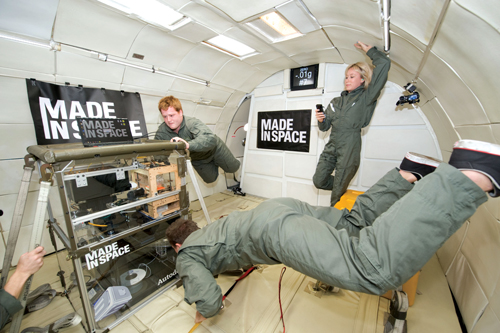
Because designers and consumers alike often make comparisons between additive manufacturing systems and Star Trek replicators, it’s exciting that some AM systems have already operated under deep-space conditions—at least for a few minutes at a time. Made in Space, a start-up company based at NASA Ames Research Center in California, won a spot in the NASA Flight Opportunity Program to operate a modified 3D Systems BfB3000 3D printer on aircraft that undergo zero-gravity conditions. Team members from Made in Space have taken the equipment on multiple flights for more than two hours of zero-gravity manufacturing time, printing research-oriented polylactic acid (PLA) parts. These test parts are core samples or columns that, when studied under microscopes in the lab, yield information about layer bonding and resolution.
More Info
Subscribe to our FREE magazine, FREE email newsletters or both!
Latest News
About the Author
Pamela Waterman worked as Digital Engineering’s contributing editor for two decades. Contact her via .(JavaScript must be enabled to view this email address).
Follow DE





